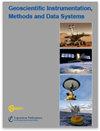Research into using a fiber Bragg grating sensor group for three-dimensional in situ stress measurement
IF 2.3
4区 地球科学
Q3 GEOSCIENCES, MULTIDISCIPLINARY
Geoscientific Instrumentation Methods and Data Systems
Pub Date : 2022-02-07
DOI:10.5194/gi-11-59-2022
引用次数: 1
Abstract
Abstract. The observation and estimation of the deep crustal stress state is a key and difficult problem for in situ stress measurement. Using a borehole wall strain gauge based on the overcoring stress-relieving method is one of the main methods of in situ stress measurement. In this paper, a strain-sensing array based on fiber Bragg grating (FBG) is designed by using the main structure of the classical hollow inclusion cell, and its layout scheme on the hollow inclusion is studied. According to the layout scheme, the in situ stress inversion algorithm of hole wall strain to stress is deduced. Following this, the triaxial loading and unloading experiment platform is built, and the calibration experiment for the FBG strain sensor is designed. Finally, Abaqus finite element software is used to simulate the in situ stress measurement process of the overcoring stress relief. The FBG strain values of each measurement direction before and after the overcoring process are extracted, and the stress inversion equation is used to carry out the stress inversion. The comparison of the inversion results proved that the FBG strain sensor group is feasible and reliable. The quasi-distributed FBG sensor module designed in this paper can invert the three-dimensional in situ stress by measuring the hole wall strain, which places a theoretical and experimental foundation for the development and application of an FBG hole wall strain gauge. It makes up for the deficiency of the existing hole wall strain gauge based on a resistance strain gauge, provides direct and accurate observations for hole wall strain measurement, and has important practical value for the development of in situ stress measurement technology.光纤光栅传感器组用于三维地应力测量的研究
摘要深部地应力状态的观测与估计是地应力测量的关键和难点。基于上覆应力消除法的井壁应变片是地应力测量的主要方法之一。本文利用经典空心包涵单元的主体结构,设计了基于光纤布拉格光栅的应变传感阵列,并研究了其在空心包涵单元上的布局方案。根据布置方案,推导了孔壁应变-应力的原位应力反演算法。在此基础上,搭建了三轴加载与卸载实验平台,设计了光纤光栅应变传感器的标定实验。最后,利用abaquusfinite - element软件模拟了覆岩应力释放的原位应力测量过程。提取复盖前后各测量方向的FBG应变值,利用应力反演方程进行应力反演。通过对反演结果的比较,证明了光纤光栅应变传感器组的可行性和可靠性。本文设计的准分布式光纤光栅传感器模块可以通过测量孔壁应变来反演三维原位应力,为光纤光栅孔壁应变的研制和应用奠定了理论和实验基础。它弥补了现有基于电阻应变仪的孔壁应变仪的不足,为孔壁应变测量提供了直接、准确的观测结果,对发展原位应力测量技术具有重要的实用价值。
本文章由计算机程序翻译,如有差异,请以英文原文为准。
求助全文
约1分钟内获得全文
求助全文
来源期刊

Geoscientific Instrumentation Methods and Data Systems
GEOSCIENCES, MULTIDISCIPLINARYMETEOROLOGY-METEOROLOGY & ATMOSPHERIC SCIENCES
CiteScore
3.70
自引率
0.00%
发文量
23
审稿时长
37 weeks
期刊介绍:
Geoscientific Instrumentation, Methods and Data Systems (GI) is an open-access interdisciplinary electronic journal for swift publication of original articles and short communications in the area of geoscientific instruments. It covers three main areas: (i) atmospheric and geospace sciences, (ii) earth science, and (iii) ocean science. A unique feature of the journal is the emphasis on synergy between science and technology that facilitates advances in GI. These advances include but are not limited to the following:
concepts, design, and description of instrumentation and data systems;
retrieval techniques of scientific products from measurements;
calibration and data quality assessment;
uncertainty in measurements;
newly developed and planned research platforms and community instrumentation capabilities;
major national and international field campaigns and observational research programs;
new observational strategies to address societal needs in areas such as monitoring climate change and preventing natural disasters;
networking of instruments for enhancing high temporal and spatial resolution of observations.
GI has an innovative two-stage publication process involving the scientific discussion forum Geoscientific Instrumentation, Methods and Data Systems Discussions (GID), which has been designed to do the following:
foster scientific discussion;
maximize the effectiveness and transparency of scientific quality assurance;
enable rapid publication;
make scientific publications freely accessible.
 求助内容:
求助内容: 应助结果提醒方式:
应助结果提醒方式:


